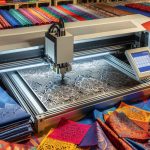To excel at laser cutting in textile design, start by selecting fabrics with tight weaves and smooth surfaces, such as organic cotton or polyester. Use CO2 lasers for natural fibers and adjust settings for synthetics. Prepare your design files in formats like SVG or DXF and make sure they're fine-tuned for clean, precise cuts. Maintain a clear workspace and inspect your laser cutter regularly to ensure safety and peak performance. After cutting, seal edges to prevent fraying and use a soft brush to clean debris. Embrace sustainable materials for eco-friendly projects. Stay tuned to unleash the full potential of your designs.
Table of Contents
Key Takeaways
- Choose tight-weave, smooth-surface fabrics like organic cotton for optimal laser cutting results.
- Utilize CO2 lasers for cutting and engraving natural fibers such as cotton and silk.
- Optimize design files with clean vector paths and appropriate dimensions for precision.
- Implement regular maintenance including daily wipe-downs and monthly exhaust system checks.
- Use sustainable practices by selecting biodegradable materials and repurposing offcuts.
Choosing the Right Fabric
Choosing the ideal fabric is crucial for achieving successful laser cutting outcomes in textile design. You'll want to start with savvy fabric selection, considering both current color trends and the specific characteristics of each textile. Understanding these aspects will set you on the path to mastery.
First, consider the fabric's composition. Natural fibers like cotton and wool typically handle laser cutting well, providing clean edges. However, synthetic fibers such as polyester and nylon can also work beautifully, especially when paired with the right surface finishes that enhance their durability and appearance.
Color trends play a significant role in your decisions. The latest hues can impact not just your design's appeal but also how well the laser cuts through the material. Light colors may show scorch marks more, while darker shades often conceal minor imperfections.
Next, focus on textile properties. Fabrics with tight weaves and smooth surfaces usually yield the best results, as they minimize fraying and guarantee precision. Surface finishes like coatings or treatments can add another layer of complexity, so choose those that complement your design goals.
Understanding Laser Types
Once you've selected the perfect fabric, it's time to understand the different types of lasers available for textile design. The most common types are CO2 lasers and fiber lasers. CO2 lasers are excellent for cutting and engraving a variety of fabrics, offering high precision and quality cuts.
Fiber lasers, on the other hand, are typically used for metals but can also handle some textiles, depending on the material.
When choosing a laser, always consider fabric compatibility. For instance, natural fibers like cotton and silk work well with CO2 lasers, while synthetic fabrics like polyester might require adjustments to prevent melting or burning. Be sure to test a small sample before committing to a large project.
Laser safety is paramount. Always wear appropriate protective gear and make sure your workspace is well-ventilated to avoid inhaling fumes. Additionally, understanding and following the manufacturer's safety guidelines will help prevent accidents and equipment damage.
Preparing Your Design Files
When preparing your design files for laser cutting, start by selecting the appropriate file formats, such as SVG or DXF, to guarantee compatibility.
Next, optimize your design dimensions to suit your material and machine specifications.
Lastly, ensure that your vector paths are clean and smooth to prevent any cutting issues.
Choosing Appropriate File Formats
To guarantee your laser-cut textile designs come out flawlessly, it's important to select the right file formats for your design files. First, consider file compatibility and the software options you're using. Most laser cutting machines support vector files like .AI (Adobe Illustrator), .DXF (Drawing Exchange Format), and .SVG (Scalable Vector Graphics). These formats guarantee your designs are scalable without losing detail, which is vital for precision cutting. Check your laser cutter's manual for the preferred file formats to avoid any hiccups.
Next, focus on resolution requirements and image quality. If you're working with raster images, opt for high-resolution files to maintain crisp edges. Formats like .PNG or .TIFF are excellent for this purpose. However, keep in mind that vector files are usually superior for laser cutting due to their scalability and detail preservation.
When preparing your design files, also pay attention to the color mode (usually RGB) and line thickness. Laser cutters interpret lines differently based on their thickness and color. By guaranteeing your files meet specific resolution and format guidelines, you'll achieve the best possible results in your textile designs.
Optimizing Design Dimensions
After selecting the right file formats, let's focus on optimizing your design dimensions to guarantee a flawless laser cutting process. Start by verifying your designs are scaled correctly for the textile you're using. Design flexibility is essential; you want to easily adjust dimensions without compromising the overall look.
Make sure to keep material compatibility in mind, as different textiles have unique thicknesses and properties that can impact the cutting process.
Next, aim for precision accuracy in your design measurements. Even minor discrepancies can throw off the entire project, leading to wasted material and time. Use vector-based software to maintain sharp, clean lines and precise dimensions. This will also aid in cutting efficiency, as the laser cutter will follow your paths more accurately, reducing the likelihood of errors.
Additionally, consider the spacing between elements in your design. Proper spacing ensures that the fabric won't tear or become overly fragile after cutting. This small step can make a significant difference in the durability and quality of your final product.
Ensuring Clean Vector Paths
Ensuring clean vector paths in your design files is vital for achieving precise and efficient laser cuts. Start by focusing on vector path accuracy. Use design software like Adobe Illustrator or CorelDRAW to create your vectors. Make sure your paths are closed and free of unnecessary points, which can cause the laser to hesitate, leading to jagged edges.
To enhance design precision, zoom in on your design and scrutinize each segment. Look for overlapping or intersecting lines that could confuse the laser cutter. Simplify complex shapes to reduce the risk of errors. Use the 'Simplify Path' function in your software to minimize points without compromising the integrity of your design.
Minimizing distortion is essential for clean cuts. Check for any irregularities by previewing the design in outline mode. This helps you catch hidden elements that might distort the final cut. Also, make use of grid and snap-to guides to keep your design elements aligned perfectly.
Optimizing Laser Settings
Finding the perfect laser configurations can significantly enhance the precision and quality of your textile designs. Start by mastering power adjustment and speed optimization. These two factors play an important role in achieving clean, crisp edges without burning or fraying the fabric. You'll need to experiment with various power levels to make sure you're using just enough to cut through the material without causing damage. Similarly, optimizing the speed of the laser can prevent overheating and guarantee that your cuts are sharp and precise.
Next, pay close attention to beam focus. A well-focused beam will make a significant difference in the accuracy of your cuts. Adjust the laser's focus according to the thickness and type of fabric you're working with. Poorly focused beams can lead to uneven cuts and wasted material.
Don't forget about material compatibility. Different textiles react differently to laser cutting. For example, natural fibers like cotton and wool might require different settings compared to synthetic materials like polyester or nylon. Always test a small sample piece first to find the ideal configurations for each specific fabric you plan to use.
Ensuring Safety Measures
While optimizing laser settings is key for quality cuts, prioritizing safety measures guarantees a secure and efficient working environment.
First, always wear appropriate safety gear. This includes safety goggles to protect your eyes from potential laser reflections and gloves to safeguard your hands from heat and sharp edges. Don't forget a mask to avoid inhaling any harmful fumes released during the cutting process.
Next, familiarize yourself with the machine's emergency procedures. Know where the emergency stop button is located and make sure it's easily accessible. This quick action can prevent accidents and damage if something goes wrong. Additionally, maintain a clear workspace to avoid tripping hazards and confirm proper ventilation to disperse harmful fumes efficiently.
Regularly inspect your laser cutter for any signs of wear or malfunction. If you notice unusual sounds or erratic behavior, pause your work and address the issue immediately. Proper maintenance not only extends the machine's life but also secures your safety.
Lastly, always keep a fire extinguisher nearby. Textiles can be highly flammable, and having a fire extinguisher within reach secures you're prepared for any unexpected flare-ups.
Post-Cutting Finishing Techniques
Once you've completed the laser cutting, it's essential to handle the finishing touches.
Start by removing any residual debris to guarantee a clean look.
Then, seal the cut edges to prevent fraying and maintain the integrity of your design.
Removing Residual Debris
To ensure your textile pieces achieve a professional finish, it's important to remove any residual debris left from the laser cutting process. Effective residual debris removal not only enhances the look of your designs but also contributes to minimizing waste.
Start by using a soft brush to gently sweep away loose particles. This simple step can make a significant difference in the overall cleanliness of your fabric.
Next, employ a small vacuum with a fine nozzle attachment to collect any remaining debris. This method guarantees thorough debris collection, reducing the environmental impact by preventing tiny fibers and particles from dispersing into the workspace. For more intricate or delicate fabrics, consider using compressed air to blow away stubborn particles without causing damage.
Additionally, a lint roller can be an excellent tool for capturing those last bits of residue. Run it gently over the surface to pick up any remaining debris. Remember, keeping your work area clean helps maintain the quality of your textiles and prolongs the life of your cutting equipment.
Sealing Cut Edges
After laser cutting your textiles, sealing the cut edges is important to prevent fraying and guarantee a polished finish. To achieve professional edge finishing, you need to contemplate fabric compatibility and the heat sensitivity of your materials.
Here's a straightforward guide to help you master this step:
- Select the Right Method: Depending on your fabric, you might opt for heat sealing, serging, or using fabric sealants. For synthetic fabrics, heat sealing can work wonders due to their melting properties. On the other hand, natural fibers might benefit more from a serger or a liquid sealant.
- Check Cutting Accuracy: Precise cuts are essential for effective edge finishing. Double-check that your laser cutter is calibrated correctly to avoid jagged edges. Clean cuts make sealing easier and more effective, ensuring a seamless finish.
- Test for Heat Sensitivity: Before finalizing your technique, test a small fabric piece. Some textiles might react poorly to heat, causing discoloration or damage. Understanding your fabric's heat sensitivity can save you from costly mistakes and guarantee a smooth edge.
Troubleshooting Common Issues
Encountering problems with laser cutting in textile design can be frustrating, but most issues have straightforward solutions. One common issue is material compatibility. If your fabric isn't cutting cleanly, it mightn't be suitable for laser cutting. Refer to your laser cutter's manual for a list of compatible materials. Troubleshooting tips include testing a small piece first and adjusting the laser's power settings to match the material's thickness and type.
Ensuring precision is another critical factor. If your cuts aren't accurate, check the machine's alignment. Misalignment can cause the laser to miss its mark, resulting in imprecise cuts. Regularly calibrate your laser cutter following your manufacturer's guidelines. Implement quality control procedures such as inspecting the cut edges for consistency and measuring the final product against your design specs to guarantee accuracy.
You might also face issues with scorch marks or fraying. To minimize these, adjust the laser's speed and power settings. Sometimes, using a backing material can help reduce residue and keep your cuts clean.
Maintaining Your Laser Cutter
To keep your laser cutter running smoothly, establish regular cleaning routines to remove debris and prevent damage. Make sure you also set up a schedule for checking key components, like the laser tube and lenses, for wear and tear.
These simple steps will help extend the lifespan of your machine and maintain its precision.
Regular Cleaning Routines
Keeping your laser cutter in peak condition requires a regular cleaning routine to maintain top performance and longevity. Cleaning frequency plays an essential role in preserving your equipment. A daily wipe-down can prevent buildup and keep your machine running smoothly.
Here are some key maintenance tips to help you stay on top of your game:
- Daily Cleaning: After each use, wipe down the laser bed and surrounding areas to remove any debris. This simple act prevents the accumulation of residue that can impact cutting precision.
- Weekly Deep Clean: Once a week, sanitize your equipment thoroughly. Focus on the lens and mirrors, as these components are prone to dust and grime. Use a lens-cleaning solution and lint-free cloth for best results.
- Monthly Maintenance: Check and clean the exhaust system to maintain it's free of obstructions. A clogged exhaust can lead to poor air quality and reduced machine efficiency.
Component Checks Schedule
In addition to regular cleaning, you should establish a component checks schedule to guarantee your laser cutter continues to operate flawlessly. Regularly inspecting and maintaining key components like the laser tube, lens, mirrors, and cooling system ensures that your machine performs at its best.
This practice not only enhances quality control but also optimizes production efficiency, essential for achieving high-quality textile designs.
Begin with a weekly inspection of the laser tube to check for any signs of wear or reduced power. Clean the lens and mirrors to prevent dust accumulation, which can affect the precision of your cuts.
Every month, examine the cooling system to make sure it's operating correctly, preventing overheating that can lead to costly repairs.
Don't forget to periodically assess the alignment of the laser beam. Misalignment can greatly impact the accuracy of your cuts, undermining your quality control efforts.
Exploring Creative Applications
Laser cutting opens up a world of creative possibilities in textile design, letting you craft intricate patterns and unique textures with precision and ease. By embracing experimental techniques and innovative approaches, you can elevate your textile projects to new heights.
Here are a few ways you can explore creative applications:
- Layering and Appliqué: Use laser cutting to create layered designs that add depth and dimension to your textiles. You can precisely cut multiple layers of fabric to construct intricate appliqué patterns that would be challenging to achieve by hand.
- Custom Lace and Embellishments: Design and cut personalized lace patterns or intricate embellishments. This not only customizes your textiles but also showcases your distinct design aesthetic. The precision of laser cutting guarantees that even the most fragile designs maintain their integrity.
- Eco-friendly Innovations: Incorporate sustainable materials and eco-conscious practices into your laser cutting projects. Utilize fabrics made from upcycled fibers or organic materials to create designs that are both aesthetically pleasing and environmentally friendly.
Sustainable Practices in Laser Cutting
Embracing sustainable practices in laser cutting not only reduces environmental impact but also enhances the ethical value of your textile designs. To start, focus on eco-friendly practices by selecting materials that are biodegradable or recyclable. Natural fabrics like organic cotton, hemp, and bamboo work exceptionally well with laser cutting and offer a smaller environmental footprint compared to synthetic alternatives.
Another key approach is upcycling materials. Instead of discarding offcuts or surplus textiles, repurpose them into new, innovative designs. This not only minimizes waste but also adds a unique, creative dimension to your work. For instance, you can transform scrap fabrics into intricate appliqués or decorative elements, giving them a second life.
Also, consider reducing your energy consumption. Modern laser cutting machines often come with eco-settings that optimize power usage without compromising precision. Regular maintenance of your equipment guarantees it runs efficiently, further lowering energy demands.
Frequently Asked Questions
What's the Average Lifespan of a Laser Cutter Used for Textiles?
A well-maintained laser cutter typically lasts around 8-10 years. Regular laser cutter maintenance greatly impacts production efficiency, ensuring you get the most out of your equipment while minimizing downtime and costly repairs.
How Does Laser Cutting Compare to Traditional Cutting Methods in Cost?
When you compare laser vs traditional cutting, laser cutting often wins in cost effectiveness. By doing a cost comparison and efficiency analysis, you'll see that lasers offer precision and speed, reducing waste and long-term expenses.
Can Laser Cutters Create Intricate Lace Patterns on Fabric?
Yes, you can create intricate lace patterns on fabric using laser cutting. This technique enhances your design's intricacy and creativity, providing precise detail that traditional methods can't match. It's perfect for achieving sophisticated textile designs.
Are There Specific Brands of Laser Cutters Recommended for Textile Use?
Imagine a laser cutter slicing through fabric like butter. You'll want brands like Epilog or Trotec known for their precise laser cutter features and excellent textile compatibility. They're perfect for achieving detailed, professional results.
How Do Environmental Factors Affect Laser Cutting Efficiency?
Environmental factors like temperature and humidity directly impact laser cutting efficiency. You've got to guarantee good air quality and ventilation, as they help maintain consistent cutting performance and protect both the machine and materials.
- How Does Ring Spun Cotton Affect Garment Fit and Shape Retention? - August 13, 2024
- What Are the Challenges in Producing Ring Spun Cotton? - August 13, 2024
- Is Ring Spun Cotton Suitable for Plus-Size Clothing? - August 13, 2024







